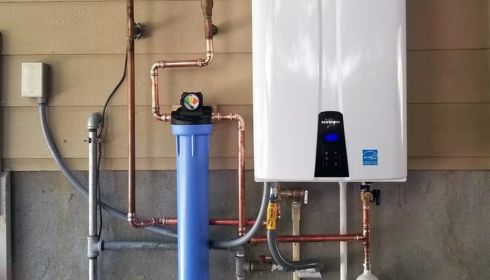There’s something oddly comforting about a hot shower at the end of a long day. You turn the handle, wait for the warmth, and let the steam fog up the mirror. But if you’ve ever stood there shivering because the hot water ran out too quickly, you’ve probably wondered if there’s a better way. That’s where the conversation around tankless water heaters comes in. They’re often praised as the future of home heating systems, but like any upgrade, there’s more to it than the shiny brochure promises.
Why Tankless Suddenly Feels Like a “Must-Have”
Tankless water heaters aren’t exactly new, but they’ve become a household buzzword in recent years. The idea sounds simple: instead of storing gallons of hot water in a big tank, a compact unit heats water only when you need it. Endless hot showers, energy savings, space efficiency — it all sounds dreamy.
But here’s the catch: moving from a traditional system to a tankless water heater installation isn’t just about plugging in a new appliance. It often requires changes to your plumbing, electrical work, sometimes even venting upgrades. The convenience is real, but so is the prep work.
The Dollars and Sense of Going Tankless
One of the first questions homeowners ask is about the money side of things. Energy-efficient systems are appealing, but the upfront costs can sting. On average, the cost to install tankless water heater systems ranges widely depending on your home setup. Are you replacing an old unit in a small condo? Or are you outfitting a large family home with multiple bathrooms?
Labor costs, permits, and whether your current infrastructure can handle the change all play a role. The truth is, while the initial investment may be higher than a standard tank, many people look at the long-term payoff — lower energy bills, a longer lifespan, and no more arguments over who used up the last of the hot water.
Electric vs. Gas: The Debate That Never Ends
Ask ten homeowners which system is better, and you’ll get ten different answers. Gas models heat quickly and tend to handle higher demand, but they usually require professional venting and sometimes gas line upgrades. On the flip side, an electric tankless water heater installation is often simpler, especially in homes without existing gas service.
Electric units can be compact, quiet, and straightforward to maintain. The trade-off? They might struggle to keep up with heavy use in large households. Some families even install multiple units — one for the kitchen, another for the bathrooms — to balance the load. It really comes down to lifestyle and how much hot water your home devours daily.
Space: The Silent Winner
If you’ve ever cursed that hulking water tank in your basement or garage, you’ll appreciate one of the underrated perks of tankless heaters: space freedom. These systems are wall-mounted and compact, sometimes no bigger than a suitcase. Suddenly that corner of your basement or utility closet is usable again. Homeowners in smaller apartments and tiny homes especially love this feature, but even in bigger houses, freeing up space feels like a win.
The Hidden Work Behind the Curtain
It’s easy to get swept up in marketing that promises instant hot water forever. But here’s the thing most ads gloss over: tankless heaters don’t always mean “instant.” The water still has to travel through your pipes, and if you live in a sprawling house, it might take a few seconds before the warmth reaches your tap. Some people add circulation pumps to shorten the wait, but that’s another cost and another piece of equipment to maintain.
Also, water quality plays a big role. Hard water can cause mineral buildup that hurts efficiency and lifespan. In areas with really hard water, pairing the system with a softener isn’t just smart — it’s essential.
Are They Worth It? Depends Who You Ask
For some, tankless heaters feel life-changing. Families with teenagers (who treat showers like concerts) swear by the endless supply. People living in small spaces adore the compact size. Energy-conscious homeowners like the efficiency numbers.
But for others, the costs and potential retrofitting requirements outweigh the benefits. If you’re planning to move in a few years, you may not see enough return to justify the switch. On the other hand, if this is your “forever home,” a tankless upgrade can feel like a smart, future-proof choice.
A Quick Word on Professional vs. DIY
There are homeowners who love a challenge, and YouTube is full of DIY installation videos. But here’s the honest truth: most tankless systems aren’t beginner-friendly projects. They involve plumbing, electrical, and sometimes gas connections — a trifecta where mistakes can be costly or unsafe. Professional installation may add to the bill, but it also brings peace of mind that the system is set up safely and up to code.
Long-Term Thinking
It’s easy to get lost in the shiny promises of modern appliances, but the real question is about lifestyle. How much hot water does your family use? Do you plan on staying in the same house long enough to reap the energy savings? Can your budget handle the upfront hit? These aren’t exciting questions, but they’re the ones that’ll help you decide if tankless is right for you.
Final Thoughts: More Than Just Hot Showers
At the end of the day, a water heater is one of those things you don’t think about — until it stops working. Tankless systems promise to change that narrative, making hot water feel endless and reliable. They save space, can cut down on energy use, and bring a modern edge to something as mundane as a shower.
But like most good things, they come with caveats: costs, infrastructure updates, maintenance needs. If you go into the decision with eyes wide open, the rewards can be worth it. And if you’re not ready for the leap just yet, that’s fine too. Sometimes, knowing what’s out there — and what it really takes — is enough to start planning for the future.
Because let’s be real: nobody likes standing under a freezing shower, waiting for the water to warm up. And if there’s a way to make that frustration disappear? Well, that’s a conversation worth having.


